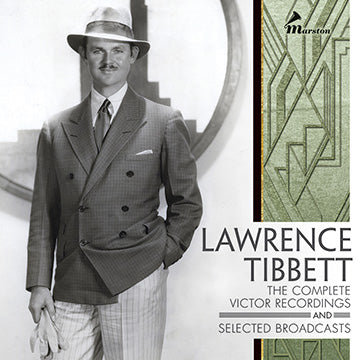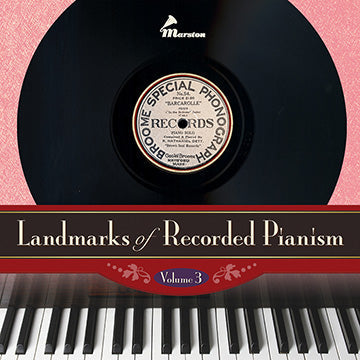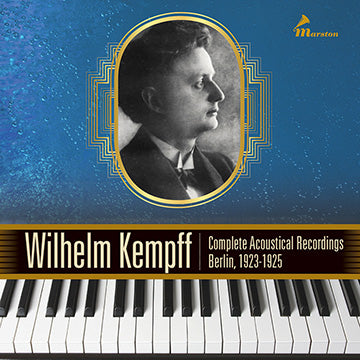Click Here to Read the Recent Wall Street Journal Article Discussing the Work of Ward Marston and Marston Records
Click here to listen to Joseph Horowitz discussing the music and artistry of the legendary baritone Lawrence Tibbett on NPR.
Now Available!

50102-2 (10 CDs) | $ 120.00
Few (if any?) opera singers have also been Academy Award nominees, let alone for Best Actor. But then again, there is only one Lawrence Tibbett (1896–1960). Described as dashing, Tibbett had a career as a movie actor, radio show personality and host, with sponsors such as Packard, Firestone, and Chesterfield. He was also one of the first “crossover” artists singing Gershwin, Kern, and Porter, and was a staple at the Met. A cogent and articulate advocate for artistic causes (rare in his day), he founded the American Guild of Musical Artists with Jascha Heifetz. But first and foremost, Lawrence Tibbett was an opera singer and one of the greatest baritones of all time.
Lawrence Tibbett signed his first contract with the Metropolitan Opera at age twenty-six and over the years built a hugely successful career. His voice was large, deep, and dark-timbred. His dynamic range (in his prime) ranged from forceful fortes to delicate pianissimos. Falstaff’s Ford was his breakthrough role and he was an outstanding Simon Boccanegra, Iago, Scarpia, and Escamillo. Tibbett was the consummate musician with an incredible stage presence. Sadly, arthritis and alcohol took its toll and Tibbett died from a fall in his apartment at age sixty-three.
Tibbett recorded exclusively for RCA Victor between 1925 and 1940, making over one hundred sides. Marston Records is pleased to present the complete Victor recordings of Tibbett for the first time. In addition, this set will include recordings made for his films, Metropolitan and Under Your Spell, as well as selections from his Packard and Chesterfield radio broadcasts never before available on compact disc. The booklet will contain many rare photos and a comprehensive essay by author and critic Conrad Osborne on Tibbett’s life, career, and recorded legacy.

52076-2 (2 CDs) | $ 42.00
This two-CD set is volume 3 in the Landmarks of Recorded Pianism series, and comprises piano solos, concerti, and two spoken reminiscences. Producers Gregor Benko and Ward Marston have selected these recordings because of their intrinsic musical and historic importance, hoping that they will merit the attention of music lovers, scholars, and collectors. Most of the offerings in this set will be completely new to collectors and enthusiasts since they are available here for the first time.
The center pieces of the set are two concerto performances taken from broadcasts, both marvelous in different ways: first we present Chopin’s F-minor concerto from a 1936 broadcast with Polish pianist, Jan Smeterlin, ably supported by the Boston Symphony Orchestra conducted by Serge Koussevitzky. A performance of both tumult and tenderness, it is the earliest known live performance of this work.
Then we offer a 1950 BBC broadcast of the Schumann concerto with 79-year-old Adelina de Lara, who had studied the work with Clara Schumann nearly sixty years earlier. De Lara gives an almost “chamber music” reading of the concerto, with subtle gradations of color and phrasing. We are also offering a third performance with piano and orchestra, but not an actual concerto. It is a seven-minute concoction of themes from the first movement of Tchaikovsky’s first concerto, made for a Coca-Cola sponsored radio program, played by the great Russian pianist, Simon Barere, with André Kostelanitz conducting the orchestra. This strange little pastiche is a new addition to the Barere discography.
For piano solo recordings, we first feature two recently discovered acoustic sides made in 1919 by African-American composer and pianist, Nathaniel Dett. These are lovely, serene readings of two short pieces from two suites, and we can only wish that we could hear more, but we have been assured that these are the only recordings of his artistry. The set also includes recordings by Australian-born pianist Elsie Hall whose only records are twelve sides made for HMV in 1930. These can be heard here for the first time in reissue, as well as a splendid performance of Bach’s C-minor Partita recorded privately when Hall was 86 years old. Our Landmarks third volume concludes by paying tribute to the English pianist, Katherine Goodson, 1872–1958. Goodson, a star pupil of Leschetizky, enjoyed a great career spanning a half-century yet sadly left us no recordings of her extraordinary artistry. Here, however, we can hear her speaking on two BBC broadcasts. First, a detailed reminiscence about her studies with Leschetizky, where she plays eight brief musical extracts. Our set concludes with Goodson giving a touching account of her week’s stay with soprano, Nellie Melba, at her Australian home.

55004-2 (5 CDs) | $ 84.00
The charismatic lyric tenor Giuseppe Anselmi (1876–1929) was idolized in Madrid, Warsaw, Buenos Aires, and Saint Petersburg during the first decade of the 20th century. He sang with success at Covent Garden and La Scala at a time when his competition was Caruso, Zenatello, Bonci, and Giorgini. Understanding the power of recordings to publicize a singer’s voice, Anselmi recorded prolifically for Fonotipia from 1907–1910 (both operatic and song repertoire) and in 1913 for Edison. His records include some of his own compositions, as well as some pieces of unusual repertoire for the time, so some of the records are quite scarce for this reason. Also an accomplished violinist, Anselmi composed in his spare time and after he ended his career in 1918 he devoted his time to teaching and composition until his untimely death from pneumonia in 1929, at fifty-two. Upon his death his heart was removed from his body and sent to Madrid’s Teatro Real, the theater of his greatest successes.
Giuseppe Anselmi is known to many for his matinee-idol good looks and arresting stage presence. Besides the typically romantic roles in which he excelled, like Des Grieux and Romeo, among his most memorable roles were Almaviva and Don Ottavio. Along with Bonci, Anselmi is considered one of the last of the bel canto tenors. But above all else, Anselmi was a refined and sophisticated musician, known for his ornamentations, elegance, diction, and mastery of recitative. Anselmi is a must-hear singer.
Anselmi’s biography has always been surrounded by a shroud of mystery to which he often contributed, especially concerning his early career and private life, so that much of what has been written about him was simply hearsay and scarcely documented. We pay homage to Anselmi by reissuing all of his Fonotipia and Edison recordings in this five-CD set, which will include numerous rare photos, complete discographic information, and two informative essays: Francisco Segalerva, a frequent contributor to The Record Collector, has written a biographical piece containing original research that sheds light on some of the most unknown episodes of Anselmi’s life and career. William Crutchfield, director of Teatro Nuovo and also a contributor to The Record Collector concentrates on the tenor’s singing and recordings providing insight into Giuseppe Anselmi the musician.

53025-2 (3 CDs) | $ 63.00
Friedrich Wilhelm Walter Kempff (1895–1991) is considered one of the great pianists of the twentieth century. One of the last chief exponents of the Germanic piano tradition, Kempff is particularly well known for his interpretations of Beethoven and Schubert. He is often best remembered for his warmth and poetic insights, sensitivity, and beautiful phrasing, yet this set of Kempff’s earliest recordings also reveal a young firebrand: a technical marvel capable of stunning, extroverted virtuosity.
Wilhelm Kempff was awarded two scholarships to the Berlin Hochschule für Musik at the age of nine: one to study piano with Heinrich Barth, and another to study composition with Brahms’s close friend and disciple Robert Kahn, both of whom had previously taught Artur Rubinstein. In 1917, Kempff gave his first major recital, consisting of predominantly major works, including Beethoven’s “Hammerklavier” and Brahms’s “Variations on a Theme of Paganini”. Kempff toured extensively during his career yet did not make his first London appearance until 1951, and his first in New York in 1964 at the ages of fifty-five and sixty-nine respectively. He gave his last public performance in Paris in 1981, and then retired for health reasons (Parkinson’s Disease).
Wilhelm Kempff recorded over a period of some sixty years, yet this set of his acoustic recordings is unique: this is the first time that these early acoustic recordings have been assembled and the only group of Kempff recordings that have never been reissued. Additionally, Kempff establishes himself as the first pianist in history to place fully a quarter of the Beethoven sonatas on disc. The final Kempff DG/Polydor acoustic recording is arguably the most historically significant, since his Beethoven First, recorded with the Berlin State Opera Orchestra in September of 1925, stands as the first commercial release of one of the staples of the modern repertoire. Notes by Stephen Siek (pianist, musicologist, piano historian, and author of England’s Piano Sage: The Life and Teachings of Tobias Matthay) round out this historically important and beautifully lyric set.




